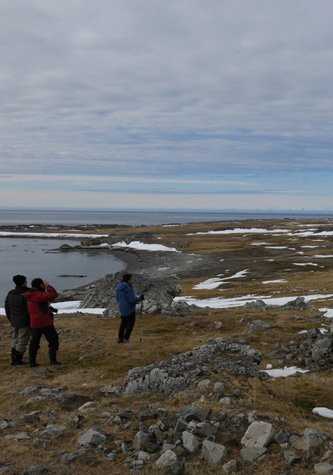It is the second day of our exploration of the Svalbard Archipelago. Just before breakfast the National Geographic Explorer entered Bellsund. This is a long fjord system running from the west into the interior of Spitsbergen. The north side of the fjord has been bathed in sunshine all spring and large areas below the cliffs are snow free and full of wildlife. We all looked up at the cliffs where kittiwakes circled above and lower on the scree slopes thousands of little auks created a cacophony of sound. With thousands of seabirds nesting the soils below are enriched with guano that fertilizes the grasses, mosses, and lichens. Amongst the green and brown carpet purple saxifrage dot the landscape.
A short Zodiac ride from the ship brought the staff and guests ashore to begin our exploration of the area around Diabasbukta. Immediately we were struck by the shear exuberance of birdlife. Scanning the area with binoculars we found reindeer grazing in the meadows and resting on the snowfields. In the grassy meadows barnacle geese grazed and up in the rocks scattered pink-footed geese stare out from their nests searching for arctic fox. Sure enough we spotted a lone fox sitting amongst the rocks looking for its chance at a meal. Purple sandpipers flew over making flight displays landing in front of us trying to attract a mate with a wing-up display.
Hiking along the sea edge we found the remains of fox traps reflecting the historical use of this landscape. We returned to the ship and moved further into Bellsund. Our afternoon destination was Van Keulenhamna where we anchored off a beautiful peninsula uplifted by glacial rebound as the land rose after the glaciers receded. In front of the ship spread before us was a vast uplifted cobble beach with mountains on one side and large pieces of former seabed uplifted above the beach.
Zodiacs ferried all aboard to the shore where the naturalists divided into groups and set out in all directions. Reindeer were abundant and often curious approaching hikers affording fantastic opportunities to take pictures. Brant geese foraged in the rich grassy meadows and purple sandpipers flew about trying to attract a mate. Some hiked up a ridge to gain fantastic views while others hiked around the peninsula.
Many hiked up the uplifted and tilted seabeds in the middle of the peninsula to gain a better view of the surroundings. As we explored these “hills” we examined the rocks more closely and discovered a rich abundance of marine fossils. These were contrasted by small patches of flowering purple saxifrage and the occasional reindeer antler.
With spectacular weather and fantastic scenery it was hard to return to the ship.







